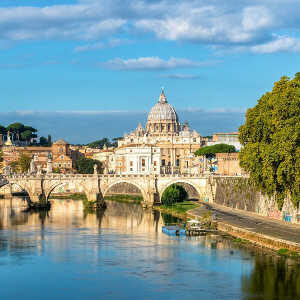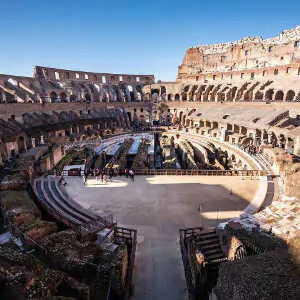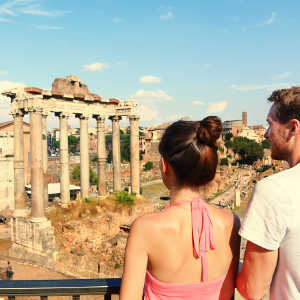Rome is home to over 2000 fountains that decorate the Eternal City and provide a valuable source of refreshment for citizens and visitors.
The trickling of water seems to follow you as you explore the cobblestone streets of Rome. From the giant monumental fountains of Trevi and Quattro Fiumi, to the small drinking fountains hydrating the city’s residents, Rome is home to over 2000 fountains. Their history goes back over 2000 years and is intertwined with the city’s stories of power and wealth.
A brief history of fountains in Rome
Not surprisingly, it was the Ancient Romans who introduced water fountains to the city using aqueducts. The aqueducts carried water from outside Rome to supply the public baths, decorative fountains and private villas of the city. The aqueducts made use of gravity to transport the water long distances.
With the fall of the Ancient Roman Empire, the aqueducts fell into disrepair and the fountains stopped working. In the 15th century, Pope Nicholas rebuilt the ruined Acqua Vergine aqueduct to restore the supply of water to Rome. He also commissioned the Renaissance architect Leon Battista Alberti to design a fountain to mark the arrival of the aqueduct on the site where the Trevi Fountain now stands.
This began a second wave of renovating ancient aqueducts and fountain construction with many of the monumental fountains in the city being commissioned by reigning popes in the 17th and 18th centuries. It was during this time, considered the golden age of the Roman fountain, that many of the impressive fountains that dot the city today were designed and constructed. These include the Trevi Fountain, fountains of Piazza Navona and the Triton Fountain.
In the 1870s a different kind of water fountain began popping up around Rome. Nasoni, named for their big nose shaped waterspouts, supplied the city’s citizens with clean drinking water before household water connections were the norm.
Rome’s Nasoni – drinking fountains for all
If you begin to feel parched as you wander Rome’s busy streets, keep your eyes peeled for the drinking fountains that offer free potable water to everyone. You can fill up your water bottle or drink straight from the fountain by plugging the spout and forcing the water to spring from a hole in the top of the nasone. The water flowing through the nasoni is the same as the water supplied to Roman households and undergoes rigorous quality checks, so you can be sure it is safe to drink. It’s the easiest way to save yourself €2 and reduce plastic use.
Introduced in the 1870s, Rome’s nasoni provide an important water supply for its citizens and visitors, but also function as release valves for the water pipes to prevent them from bursting. By keeping the water constantly running, they prevent it from stagnating and allowing the build-up of bacteria. While the number of nasoni in the city has roughly halved from 5,000 at its peak, there are still plenty around the city to offer you hydration. You can even download the Nasoni app to help you find them!
Top Monumental Fountains
While Rome’s nasoni fountains are a welcome source of refreshment on a hot day, it’s the city’s decorative fountains that travellers come to see. Designed by some of the best architects of the Renaissance and Baroque periods, the fountains are some of the top attractions in a city that’s hardly short on history, art and architecture. Make sure you include these top fountains in your itinerary as you explore the city.
-
Trevi Fountain
Probably the most famous of these monumental fountains is the Fontana di Trevi. The Trevi Fountain stands on the arrival site of the aqueduct Acqua Vergine and features in the iconic Federico Fellini film La Dolce Vita. A few popes and architects had a hand in the financing and design of the fountain, which depicts the personification of all the oceans and seas, and the most recent restoration funded by fashion house Fendi. Throwing a coin into the fountain is said to secure your return to Rome, with the money collected and given to a local charity for the homeless.
-
Fountain of the Four Rivers
Piazza Navona holds no less than three fountains, but the most impressive is the Gian Lorenzo Bernini designed Fontana dei Quattro Fiumi. The sculpture, commissioned by Pope Innocent X, represents the four major rivers of the four continents under papal influence – Danube (Europe), Nile (Africa), Ganges (Asia) and Plate (Americas).
-
Fountain of the Boat
Sitting at the foot of the Spanish Steps is the Fontana della Barcaccia, a smaller fountain in the shape of a boat. The design by Pietro Bernini was inspired by a legend in which a boat was carried to the Piazza di Spagna during a flooding of the Tiber River. As with all Roman fountains, the water flows entirely thanks to gravity, and Bernini built this fountain slightly below street level to account for the low water pressure from the Acqua Vergine in the square.
-
Triton Fountain
Another masterpiece from the sculptor Gian Lorenzo Bernini is the Fontana del Tritone in Piazza Barberini. It depicts the Greek sea god as half man, half fish as he bursts from a clam blowing a shell horn.
Also worth discovering
You might not have time to find and photograph all of Rome’s 2000 plus fountains, but these fountains are also worth discovering as you explore the city
- Turtle Fountain – found in the Jewish Ghetto, this fountain is named for the bronze turtles that sit on the basin rim.
- Fontana dell’Acqua Paola – visiting this impressive fountain standing on the arrival of the aqueduct from which it derives its name also offers spectacular views of Rome from the Gianicolo Hill.
- Fountain of the Bees – this modest fountain, by Rome’s standards, is decorated by bees, the symbol of the powerful Barberini family.
- The Four Fountains – on each corner at the intersection of of Via del Quirinale and Via delle Quattro Fontane stands a different Renaissance fountain.
Related article: Your Bucket List for Italy




